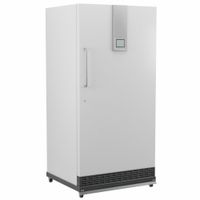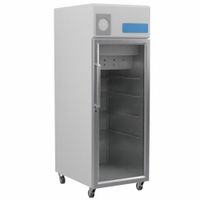Call +(254) 703 030 000 / 751 483 999 / 721 704 777
- Home
- Lab Supplies
- Lab Cooling Refrigeration
- Lab Refrigerators Freezers
.....Read More
Frequently Asked Questions
What is the ideal temperature range for a lab refrigerator?
The ideal temperature range for a lab refrigerator is typically between 2°C and 8°C (36°F to 46°F). This range is crucial for maintaining the integrity and stability of various biological samples, reagents, and pharmaceuticals stored within.
Maintaining this temperature range ensures that biological samples, such as enzymes, antibodies, and cell cultures, remain viable and effective for research purposes. It also prevents the degradation of sensitive reagents and chemicals, which could compromise experimental results. For pharmaceuticals, this range is essential to preserve their efficacy and safety, as deviations can lead to reduced potency or spoilage.
Lab refrigerators are equipped with precise temperature control systems and alarms to alert users of any deviations from the set range. Regular monitoring and calibration are necessary to ensure consistent performance. Additionally, lab refrigerators should not be overcrowded, as this can impede air circulation and lead to temperature fluctuations.
In summary, maintaining a temperature range of 2°C to 8°C in lab refrigerators is critical for the preservation of sensitive materials, ensuring the reliability and accuracy of scientific research and pharmaceutical storage.
How often should lab refrigerators and freezers be calibrated?
Lab refrigerators and freezers should be calibrated at least once a year to ensure accurate temperature control and compliance with regulatory standards. However, the frequency can vary based on several factors, including the type of equipment, its usage, and specific industry requirements. For critical applications, such as those involving pharmaceuticals, vaccines, or biological samples, more frequent calibration, such as biannually or quarterly, may be necessary to maintain stringent temperature conditions.
Calibration should also be performed whenever the equipment is newly installed, after any repairs or maintenance that could affect temperature control, and if there are any significant deviations in temperature readings. Regular calibration helps in identifying and correcting any discrepancies in temperature settings, ensuring the integrity and safety of stored materials.
In addition to scheduled calibrations, it is essential to conduct routine temperature monitoring and maintenance checks. This includes daily temperature logging, checking for signs of wear and tear, and ensuring that the equipment is functioning correctly. Automated monitoring systems can provide continuous data and alerts for any temperature excursions, aiding in maintaining optimal conditions.
Ultimately, the calibration schedule should align with the manufacturer's recommendations, industry best practices, and any applicable regulatory guidelines to ensure the reliability and accuracy of lab refrigerators and freezers.
What are the common features to look for in a lab refrigerator-freezer?
When selecting a lab refrigerator-freezer, consider the following features:
1. **Temperature Control and Stability**: Look for precise temperature control with digital displays and alarms for deviations. Stability is crucial for preserving sensitive samples.
2. **Capacity and Size**: Choose a unit that fits your space and meets your storage needs. Consider both the internal capacity and external dimensions.
3. **Energy Efficiency**: Opt for energy-efficient models to reduce operational costs and environmental impact. Look for Energy Star ratings or similar certifications.
4. **Temperature Range**: Ensure the unit covers the required temperature range for your specific applications, whether for refrigeration or freezing.
5. **Construction and Durability**: Stainless steel interiors and exteriors are preferred for durability and ease of cleaning. Ensure robust construction to withstand frequent use.
6. **Security Features**: Look for lockable doors and password-protected digital controls to prevent unauthorized access.
7. **Defrost System**: Automatic defrost systems are convenient and maintain consistent temperatures, reducing maintenance needs.
8. **Shelving and Storage Options**: Adjustable shelves and compartments allow for flexible storage configurations to accommodate various sample sizes.
9. **Noise Level**: Consider models with low noise output, especially if the unit is placed in a shared or quiet environment.
10. **Backup Systems**: Some units offer backup power options or battery systems to maintain temperature during power outages.
11. **Compliance and Certification**: Ensure the unit meets relevant industry standards and certifications, such as UL, CE, or ISO.
12. **Warranty and Support**: Check for comprehensive warranties and reliable customer support for maintenance and repairs.
13. **Additional Features**: Consider features like data logging, remote monitoring, and connectivity options for enhanced functionality and monitoring.
How do you ensure the safety and security of samples in lab refrigerators?
To ensure the safety and security of samples in lab refrigerators, several measures can be implemented:
1. **Access Control**: Limit access to authorized personnel only. Use key card systems, biometric scanners, or lock-and-key mechanisms to control who can open the refrigerator.
2. **Temperature Monitoring**: Install continuous temperature monitoring systems with alarms to alert staff of any deviations from the required temperature range. This helps prevent sample degradation.
3. **Regular Maintenance**: Schedule routine maintenance checks to ensure the refrigerator is functioning properly. This includes cleaning, checking seals, and verifying temperature accuracy.
4. **Inventory Management**: Implement a robust inventory management system to track samples. Use barcoding or RFID tags to log sample details, storage location, and retrieval history.
5. **Backup Power Supply**: Equip refrigerators with an uninterruptible power supply (UPS) or connect them to emergency power generators to maintain operation during power outages.
6. **Security Cameras**: Install surveillance cameras to monitor access and activities around the refrigerator. This deters unauthorized access and provides a record of incidents.
7. **Alarm Systems**: Use alarm systems that trigger alerts for unauthorized access attempts or prolonged door openings, ensuring immediate response to potential security breaches.
8. **Training and Protocols**: Train staff on proper handling and storage procedures. Establish clear protocols for sample storage, retrieval, and emergency situations.
9. **Labeling and Segregation**: Clearly label samples and segregate them based on type, hazard level, or storage requirements to prevent cross-contamination and ensure easy identification.
10. **Audit and Compliance**: Conduct regular audits to ensure compliance with safety and security protocols. Update procedures based on audit findings and evolving best practices.
By integrating these measures, labs can effectively safeguard their samples, ensuring both their integrity and security.
What is the difference between a lab refrigerator and a regular household refrigerator?
A lab refrigerator and a regular household refrigerator differ primarily in their design, purpose, and features.
Lab refrigerators are specifically designed for storing sensitive materials such as chemicals, biological samples, and pharmaceuticals. They maintain a consistent and precise temperature, often with a narrower range than household models, to ensure the integrity of stored items. These refrigerators often include features like alarms for temperature fluctuations, digital temperature displays, and locks for security. They are constructed with materials that resist corrosion and contamination, and they may have compartments or shelving designed to accommodate specific types of lab equipment or containers.
In contrast, regular household refrigerators are designed for general food storage. They prioritize energy efficiency, convenience, and cost-effectiveness. Household models typically have a wider temperature range suitable for preserving food and beverages. They often include features like adjustable shelves, crisper drawers, and ice makers, which are not necessary in lab settings. The design focuses on maximizing storage space and user-friendly access to food items.
Additionally, lab refrigerators often comply with specific regulatory standards to ensure safety and reliability in a laboratory environment, whereas household refrigerators are built to meet general consumer safety standards. The construction and insulation of lab refrigerators are typically more robust to handle frequent door openings and maintain temperature stability, which is crucial for preserving the integrity of lab samples.
Overall, the key differences lie in the precision, construction, and purpose of the refrigerators, with lab models tailored for scientific and medical use, and household models designed for everyday food storage.
How do you prevent cross-contamination in lab refrigerator-freezers?
To prevent cross-contamination in lab refrigerator-freezers, follow these guidelines:
1. **Segregation**: Store different types of samples (e.g., biological, chemical, radioactive) in separate compartments or dedicated units to prevent cross-contamination.
2. **Labeling**: Clearly label all samples with relevant information, including contents, date, and hazard level. Use color-coded labels for easy identification.
3. **Sealed Containers**: Use airtight, leak-proof containers to store samples. This prevents spills and limits the spread of contaminants.
4. **Regular Cleaning**: Implement a routine cleaning schedule using appropriate disinfectants. Clean spills immediately to prevent contamination.
5. **Inventory Management**: Maintain an organized inventory system to track sample locations and reduce unnecessary handling.
6. **Temperature Monitoring**: Ensure the refrigerator-freezer maintains a consistent temperature. Fluctuations can compromise sample integrity and increase contamination risk.
7. **Access Control**: Limit access to authorized personnel only. Train staff on proper handling and storage procedures.
8. **Personal Protective Equipment (PPE)**: Require the use of gloves, lab coats, and other PPE when handling samples to minimize contamination.
9. **Decontamination Protocols**: Establish protocols for decontaminating equipment and surfaces after handling hazardous materials.
10. **Regular Audits**: Conduct regular audits to ensure compliance with storage protocols and identify potential contamination risks.
11. **Separate Equipment**: Use dedicated equipment (e.g., pipettes, racks) for different sample types to avoid cross-use.
12. **Proper Disposal**: Dispose of expired or unused samples according to safety guidelines to prevent contamination from decaying materials.
By implementing these practices, you can significantly reduce the risk of cross-contamination in lab refrigerator-freezers, ensuring sample integrity and safety.
What are the energy efficiency considerations for lab refrigerators and freezers?
Energy efficiency considerations for lab refrigerators and freezers include:
1. **Insulation Quality**: High-quality insulation minimizes heat exchange, reducing the energy needed to maintain low temperatures.
2. **Compressor Efficiency**: Modern, efficient compressors consume less energy while providing effective cooling. Variable speed compressors adjust their operation based on demand, enhancing efficiency.
3. **Temperature Uniformity**: Ensuring consistent temperature distribution reduces the need for frequent compressor cycles, saving energy.
4. **Door Design and Seals**: Tight-sealing doors with robust gaskets prevent cold air leakage, reducing energy consumption. Automatic door closers and alarms for open doors can further enhance efficiency.
5. **Defrost Mechanisms**: Automatic and efficient defrost systems prevent ice build-up, which can hinder performance and increase energy use.
6. **Energy Star Certification**: Appliances with Energy Star certification meet specific energy efficiency criteria, ensuring reduced energy consumption.
7. **Size and Capacity**: Choosing the right size for the intended use prevents overcooling and unnecessary energy expenditure.
8. **Temperature Set Points**: Setting appropriate temperature levels avoids excessive cooling, which can waste energy.
9. **Maintenance**: Regular maintenance, including cleaning coils and checking seals, ensures optimal performance and energy efficiency.
10. **Lighting**: LED lighting consumes less energy and generates less heat compared to traditional lighting, reducing the cooling load.
11. **Monitoring and Controls**: Advanced monitoring systems and controls optimize operation, reducing energy use by adjusting to real-time conditions.
12. **Heat Recovery Systems**: Some systems can recover waste heat for other uses, improving overall energy efficiency.
13. **Location**: Placing units away from heat sources and ensuring adequate ventilation can reduce the cooling load and energy consumption.
14. **Load Management**: Efficient organization and loading practices minimize the time doors are open, reducing energy loss.


